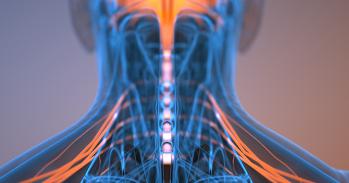From rainbow coloured liquid-crystal molecules, to tunnels deep under the ground, this year’s entries from the University of Cambridge Department of Engineering photo competition help to bring engineering brightly and vividly to life.
From rainbow coloured liquid-crystal molecules, to tunnels deep under the ground, this year’s entries from the University of Cambridge Department of Engineering photo competition help to bring engineering brightly and vividly to life.
The winning images tell wonderful stories of engineering students, researchers and academics seeking to discover new scientific truths and advance technology
Philip Guildford
Laser light diffracted by a hologram, microscopic details from a man-made fabric and photos from the deepest tunnels of the London Underground are among an array of stunning images which have been put online following the annual photographic competition at the University of Cambridge Department of Engineering.
The competition aims to show that engineering is not only about fixing machines and building bridges, but involves everything from studying objects and processes in microscopic detail, to building towering structures. The winning images can be viewed online from today via the University’s website, www.cam.ac.uk, where they can be accessed alongside dozens of other entries.
The competition, sponsored by Zeiss, international leaders in the fields of optics and optoelectronics, had five categories this year; alongside those for first, second and third place, prizes were awarded for a micrograph captured using an electron microscope, the Zeiss SEM prize, and a Head of Department’s prize for the photo or video with the most innovative engineering story behind it.
The images entered must be related to research or teaching undertaken in the Department, or out in the field; anyone working in the Department is eligible to enter, whether a professor, student, or member of support staff. Entrants were told that the images they entered may be “beautiful, fascinating, intriguing, amusing, or possibly all of these things”.
The panel of judges included Dr Allan McRobie, Professor Dame Ann Dowling and Philip Guildford, all members of the Department of Engineering. Ken Robinson, Senior Applications Specialist at Zeiss, also judged the entries. Philip Guildford, Director of Research , said that entries for this year’s competition had once again impressed the judging panel.
"The winning images are diverse, beautiful and meaningful,” Guildford said. “They all tell wonderful stories of engineering students, researchers and academics seeking to discover new scientific truths and advance technology. The winners give an eye-catching glimpse of work in the Department of Engineering, but there were over 150 other entrants this year, each communicating their unique message of how engineering is advancing and helping the World. The breadth and quality of work is quite staggering."
The first place prize was awarded to Ananta Palani’s entry entitled “Diffraction Sun”. The PhD student shone a laser light onto a small liquid crystal device, causing the light to interfere with itself and become diffracted. Palani’s sun-like image is the result of this diffraction. The research behind this image could potentially help create a microscope that would allow people to see very fast and very small objects, such as a virus infecting a cell, which at the moment can only be observed with great difficulty.
Ioannis Mastoris and Ronan Daly were the joint winners of the second prize with their electron microscopy image of the reflective coating and fibrous cloth of a man-made fabric. This photograph was taken as part of a research project focusing on the lifecycle of these fabrics, from which the findings could be utilised to help decrease the environmental impact of the fibre-dyeing process.
Phil Catton, who works in the Department’s Centre for Smart Infrastructure and Construction (CSIC), won third prize for his image entitled “Mirror Finish”. In this photograph researchers are using a 3D laser scanner to measure deformations in the London Underground Northern Line station at Euston. The information collected will then be fed into CSIC-developed models for analysis, in order to predict the behaviour of future complex tunnel geometries; these predictions will be a valuable tool in the future as new underground tunnels are built.
The Zeiss SEM prize was awarded to Brajith Srigengan for his image of an osteoblast (bone cell) branching across two steel fibres. It was photographed as part of a research project focusing on the effect that coating a hip implant with fibrin, a protein gel, has on the body’s inflammation process. A 3D steel fibre network was used as an in-vitro model of the implant. The images were then used to provide a qualitative analysis of the response.
Finally, the Head of Department prize was awarded to Khaow Tonsomboon for his video showing, step-by-step, how fibre-reinforced hydrogels can be created to mimic the structure and composition of a cornea, the transparent front part of the eye. These hydrogels have potential real-world applications, especially as the manufacturing process is cost-effective, simple, and involves non-toxic components.
There were many other outstanding images entered into this competition, including Kai Ying’s Chemical Vapour Deposition (CVD) graphene samples that look like a starry sky at night , Eric Pickering’s sequential frames charting a ballistic impact, and Tom Rainforth’s flower shaped simulation of a chaotic attractor.
This work is licensed under a Creative Commons Licence. If you use this content on your site please link back to this page.




